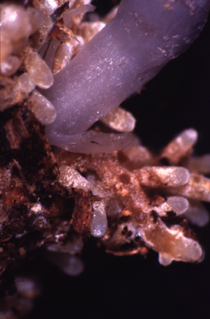Myco-heterotrophy

Myco-heterotrophy (from
Relationship between myco-heterotrophs and host fungi

Full (or obligate) myco-heterotrophy exists when a non-photosynthetic plant (a plant largely lacking in chlorophyll or otherwise lacking a functional photosystem) gets all of its food from the fungi that it parasitizes. Partial (or facultative) myco-heterotrophy exists when a plant is capable of photosynthesis, but parasitizes fungi as a supplementary food supply. There are also plants, such as some orchid species, that are non-photosynthetic and obligately myco-heterotrophic for part of their life cycle, and photosynthetic and facultatively myco-heterotrophic or non-myco-heterotrophic for the rest of their life cycle.[2] Not all non-photosynthetic or "achlorophyllous" plants are myco-heterotrophic – some non-photosynthetic plants like dodder directly parasitize the vascular tissue of other plants.[3] The partial or full loss of photosynthesis is reflected by extreme physical and functional reductions of plastid genomes in mycoheterophic plants,[4] an ongoing evolutionary process.[5]
In the past, non-photosynthetic plants were mistakenly thought to get food by breaking down
The interface between the plant and fungal partners in this association is between the roots of the plant and the mycelium of the fungus. Myco-heterotrophy therefore closely resembles mycorrhiza (and indeed is thought to have evolved from mycorrhiza),[6] except that in myco-heterotrophy, the flow of carbon is from the fungus to the plant, rather than vice versa.[8][9]
Most myco-heterotrophs can therefore be seen as ultimately being
In congruence with older reports, it has been recently shown that some myco-heterotrophic orchids can be supported by saprotrophic fungi, exploiting litter- or wood-decaying fungi.[13] In addition, several green plants (evolutionarily close to myco-heterotrophic species) have been shown to engage in partial myco-heterotrophy, that is, they are able to take carbon from mycorrhizal fungi, in addition to their photosynthetic intake.[14][15]
Species diversity of myco-heterotrophs and host fungi
Myco-heterotrophs are found among several plant groups, mainly
References
- PMID 17139846.
- ^ S2CID 85142620.
- ^ Dawson, JH; Musselman, LJ; Wolswinkel, P; Dörr, I (1994). "Biology and control of Cuscuta". Reviews of Weed Science. 6: 265–317.
- .
- PMID 29502351.
- ^ PMID 15998389.
- ^ .
- PMID 33832180.
- PMID 15315895. Archived from the original(PDF) on 2011-03-31. Retrieved 2020-08-19.
- S2CID 17479936.
- ^ Peter Kennedy (November 2005). "Common Mycorrhizal Networks: An Important Ecological Phenomenon". MykoWeb (originally published on Mycena News). Retrieved January 19, 2012.
- .
- PMID 19694964.
- PMID 33873535.
- PMID 19162524.
- . Retrieved 23 October 2023.
- ISBN 3-540-00204-9. (NOTE: this PDF is from the page proofs, and is not identical to the published version)
- ^ S2CID 85629763.
Further reading
- Hershey, DR (1999). "Myco-heterophytes and parasitic plants in food chains". American Biology Teacher. 61 (8): 575–578. JSTOR 4450771.
- Hibbett, DS (2002). "When good relationships go bad" (PDF). S2CID 17311635. Archived from the original(PDF) on 2008-12-16.
- Werner PG. 2006. Myco-heterotrophs: hacking the mycorrhizal network. Mycena News 57(3): 1,8.
- Dr. Martin Bidartondo: Selected publications
- D. Lee Taylor Lab: Recent Publications
- M.-A. Selosse's publications
External links
- The Strange and Wonderful Myco-heterotrophs The Parasitic Plant Connection, SIU Carbondale, College of Science.
- Wayne's Word Noteworthy Plant For June 1997: Fungus Flowers – Flowering Plants that Resemble Fungi by WP Armstrong.
- Fungus of the Month for October 2002: Monotropa uniflora by Tom Volk, TomVolkFungi.net
- Martín's Treasure Chest – images of myco-heterotrophs by mycologist Martín Bidartondo.
